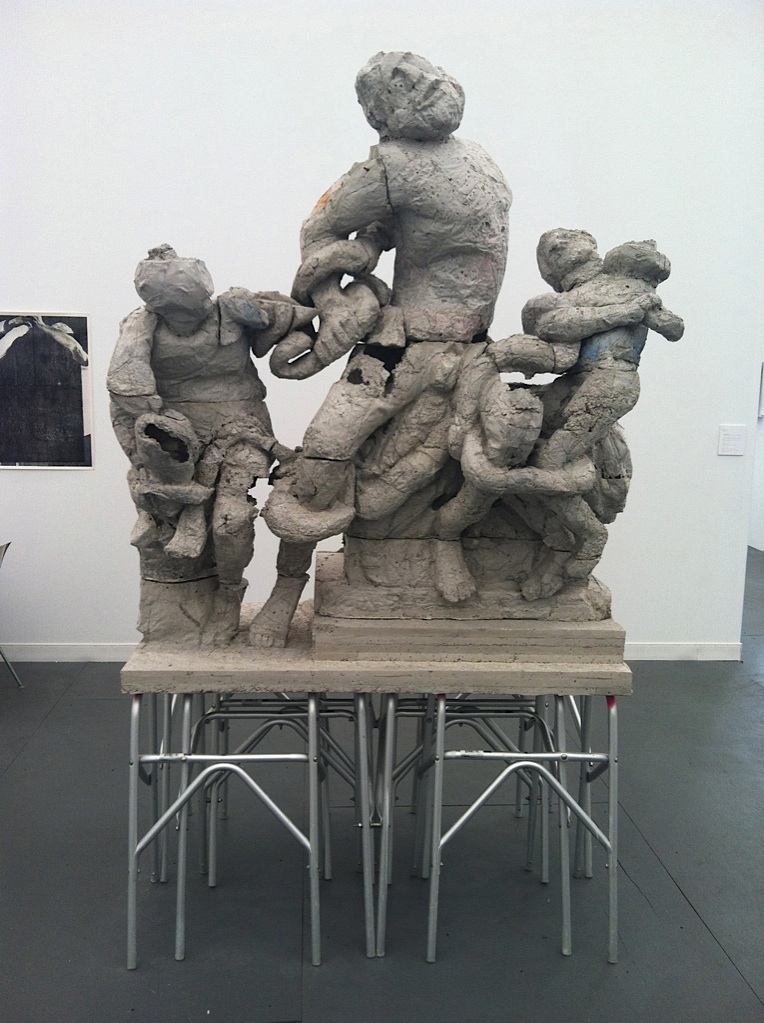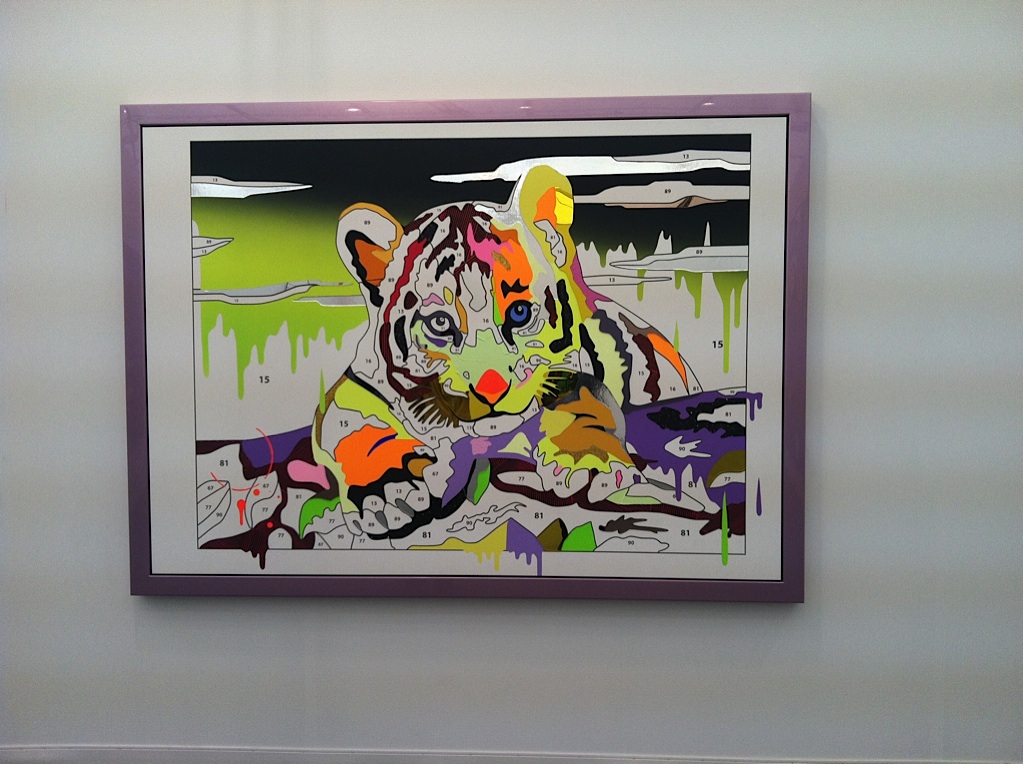Whitehot Magazine
April 2024
"The Best Art In The World"
"The Best Art In The World"
April 2024
May 2012: Frieze New York Randall's Island
 From background: Dexter Dalwood, ‘Mapplethorpe’s First Loft,’ 1999, oil on canvas; Nicola L,
From background: Dexter Dalwood, ‘Mapplethorpe’s First Loft,’ 1999, oil on canvas; Nicola L,
‘Eyelamp (green),’ 1969, plexiglas, isis green, metal stand; Marjorie Strider, ‘Charcoal Bag (blue)’
and ‘Charcoal Bag (black),’ 2012, fiberglass, resin, foam, acrylic paint. From Broadway 1602.
Frieze New York
Randall's Island
May 4-May 7, 2012
http://friezenewyork.com
Frieze New York debuted on Randall's Island the first weekend in May, swept up in the momentum of its international reputation. The fair has been a yearly highlight in London since 2003. Nearly 200 galleries were presented in this first installment, including thirty-three in the "Focus" section (galleries that had opened in or after 2001) and twenty in the "Frame" section (galleries established less than six years ago). An incredible sculpture park, curated by Tom Eccles, provided respite at the far end of the fair with entries by Ernesto Neto, Gabriel Kuri, and Katja Strunz, among others. A slew of commissioned projects and public artworks infiltrated the island via Frieze Projects, curated by Cecilia Alemani. Virginia Overton's folded mirrors squeezed between trees and branches on the grassy patch near the fair's entrance. Joel Kyack's carnival games taunted passersby with one chance to snag an unlikely win at simple tasks with disheartening constructions. The strength of the Projects rested in their ability to engage visitors with the environment and mutate the art fair into an experience rather than trudge through capitalism.
Inside the slithering white tent, designed by Brooklyn architecture firm SO-IL, neutral light and a plethora of food options were an immediate contrast to the springtime art fairs. Aided by a wedged design, there were a number of wide open spaces that provided grounds for ambitious sculpture and installations. Regardless of such praise, it remained abundantly clear that an art fair is not the ideal scene for looking at art. Charlotte Moth's untitled (2012), shown at Marcelle Alix, consisted of wooden light boxes that completely lost any semblance of shape or intrigue in the tent's pure illumination. Justin Matherly's concrete sculpture, entitled Everybody moves, sometimes slowly, sometimes quickly (dedicate to everyone) (2012), found the conditions much more favorable. The enormous sculpture's writhing, bulbous figures are caught halfway between a struggle and a triumph reminiscent of Laocoon and his sons (200 B.C). The obscured faces and the shiny ambulatory supports summoned a vanitas scene in the white light, describing one's struggle with the ego in a powerful simplification.
The idea of reduction, of allowing art to speak forcefully from the lowest common denominator, manifested in several ways at Frieze. Matt Golden's found picture-frame chairs from his Maverick series at Limoncello address dead-end design. Rather than preach of their function, Golden provides art for art's sake that highlights construction and negative space. This conceptual reduction carried over into Anselm Reyle's paint-by-number canvases at Contemporary Fine Arts Berlin. His appropriated Lisa Frank motifs and abstract compositions on gigantic canvases juxtaposed simplicity and reduction. Despite having a definitive framework for the images, Reyle integrated the artist's hand by way of drips of paint, patterns, and fades. By highlighting the mysterious appeal of neon, kittens, and rules, Reyle challenged one's understanding of the formulaic.
The splendor and excess associated with these fairs appeared more restrained than usual at Frieze. Rather than an inventory overflowing with Warhols and neon, some of the stronger work enlivened art historical references. Donald Baechler's Clay Pot Flowers (2011), for example, spoke to the quality of bronze and its character. The sculpture resembled a prehistoric totem or cave painting in its minimal detail and commanding presence. Other work utilized modern mediums to stir memories of forlorn techniques. Yann Serandour's UV printed photographs captured ornate mirrors on brushed aluminum. This World Mirrors series, reminiscent of the daguerrotype's silver surface, suggest a medium torn between the reality of the subject and its inability to discover the truth within them. Stelios Faitakis's Let's define intelligence (2011) at The Breeder was perhaps the most potent example of this trend, assuming Byzantine qualities of skewed perspective and segmented drapery melding with modern homelessness and graffiti. His apocalyptic suggestions of falling fireballs and wealthy yet unrelenting tax-men was a paranoia of the past that might outlive us all.
Frieze provided a weekend of sunshine, an optimistic interaction for the second overhaul of art fairs in New York in less than three months. The single scapegoat, however, had to be Frieze Sounds: a program of commissioned audio works hoarded by the invisible BMW shuttles to the fair. The works included sounds by Rick Moody, Martin Creed, and Frances Stark that would have been a welcome replacement for the FoxNews intrusion on the Water Taxis. Even so, the fair was a combination of open space and good vibes on Randall's Island. Who even thought an art fair could be so pleasantly unpredictable?
 Donald Baechler, ‘Clay Pot Flowers,’ 2012, bronze, edition 1 of 8.
Donald Baechler, ‘Clay Pot Flowers,’ 2012, bronze, edition 1 of 8.
 Matt Golden, ‘Maverick (XX)’ and ‘Maverick (XIX),’ 2011, found picture frames. From Limoncello.
Matt Golden, ‘Maverick (XX)’ and ‘Maverick (XIX),’ 2011, found picture frames. From Limoncello.
 Yann Serandour’s World Mirrors series, 2011, UV printing on brushed aluminum. From gb agency.
Yann Serandour’s World Mirrors series, 2011, UV printing on brushed aluminum. From gb agency.
 Alison Elizabeth Taylor, ‘Multiple Shots with Knife Slashes,’ 2010, wood veneer,
Alison Elizabeth Taylor, ‘Multiple Shots with Knife Slashes,’ 2010, wood veneer,
oil paint, and shellac. From James Cohan Gallery.
 Jim Shaw from the Forces of Nature/Hair series, 2011, ink on paper. From Metro Pictures.
Jim Shaw from the Forces of Nature/Hair series, 2011, ink on paper. From Metro Pictures.
 Matthew Day Jackson, ‘Seated not Defeated (Chief Bigfoot),’ 2012,
Matthew Day Jackson, ‘Seated not Defeated (Chief Bigfoot),’ 2012,
bronze, patina. From Hauser & Wirth.
 Michael Raedecker, 'Presentation,' 2011-12, acrylic and thread on canvas. Shown at Hauser and Wirth.
Michael Raedecker, 'Presentation,' 2011-12, acrylic and thread on canvas. Shown at Hauser and Wirth.
 Justin Matherly, ‘Everybody move, sometimes slowly, sometimes quickly (dedicate to everyone),
Justin Matherly, ‘Everybody move, sometimes slowly, sometimes quickly (dedicate to everyone),
’ 2012, glass reinforced concrete and ambulatory devices. From Bureau in the ‘Focus’ section.
 Evgeny Antufiev, ‘untitled,’ 2010, textiles, glue, plastic, synthetic insulation.
Evgeny Antufiev, ‘untitled,’ 2010, textiles, glue, plastic, synthetic insulation.
From Regina Gallery.
 Thomas Zipp, ‘A.B. PEAK DEVIATION,’ 2011, silkscreen, acrylic, oil on canvas.
Thomas Zipp, ‘A.B. PEAK DEVIATION,’ 2011, silkscreen, acrylic, oil on canvas.
From Galerie Krinzinger.
 Evgeny Antufiev, ‘untitled,’ 2010, textiles, glue, plastic, synthetic insulation. From Regina Gallery.
Evgeny Antufiev, ‘untitled,’ 2010, textiles, glue, plastic, synthetic insulation. From Regina Gallery.
 Anselm Reyle at Contemporary Fine Arts Berlin.
Anselm Reyle at Contemporary Fine Arts Berlin.
 David Maljkovic, ‘untitled,’ 2012, plant, shelf. From Metro Pictures.
David Maljkovic, ‘untitled,’ 2012, plant, shelf. From Metro Pictures.
 Stelios Faitakis, ‘Let’s define intelligence,’ 2011, mixed media on canvas. From The Breeder, Athens.
Stelios Faitakis, ‘Let’s define intelligence,’ 2011, mixed media on canvas. From The Breeder, Athens.

Lynn Maliszewski
Lynn Maliszewski is a freelance writer and aspiring curator/collector residing in New York City. She can be reached at l.malizoo@gmail.com
PHOTO CREDIT: Benjamin Norman (www.benjaminnorman.com)








